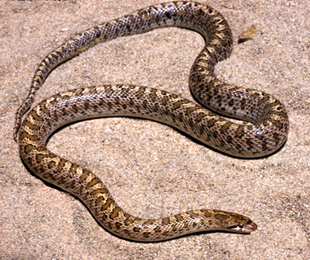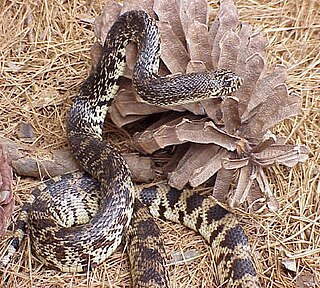
The California kingsnake is a nonvenomous colubrid snake endemic to the western United States and northern Mexico, and is found in a variety of habitats. Due to ease of care and a wide range of color variations, the California kingsnake is one of the most popular snakes in captivity.

Pituophis is a genus of nonvenomous colubrid snakes, commonly referred to as gopher snakes, pine snakes, and bullsnakes, which are endemic to North America.

Pituophis catenifer is a species of nonvenomous colubrid snake endemic to North America. Nine subspecies are currently recognized, including the nominotypical subspecies, Pituophis catenifer catenifer, described here. This snake is often mistaken for the prairie rattlesnake, but can be easily distinguished from a rattlesnake by the lack of black and white banding on its tail and by the shape of its head, which is narrower than a rattlesnake's.

Arizona elegans is a species of medium-sized colubrid snake commonly referred to as the glossy snake or the faded snake, which is endemic to the southwestern United States and Mexico. It has several subspecies. Some have recommended that A. elegans occidentalis be granted full species status.

Pituophis catenifer affinis, commonly known as the Sonoran gopher snake, is a nonvenomous subspecies of colubrid snake that is endemic to the southwestern United States. It is one of six recognized subspecies of the gopher snake, Pituophis catenifer.

Nerodia rhombifer, commonly known as the diamondback water snake, is a species of nonvenomous natricine colubrid endemic to the central United States and northern Mexico. There are three recognized subspecies of N. rhombifer, including the nominotypical subspecies.

The speckled kingsnake is a nonvenomous species of kingsnake endemic to the United States.

Pantherophis emoryi, commonly known as the Great Plains rat snake, is a species of nonvenomous rat snake in the family Colubridae. The species is native to the central part of the United States, from Missouri to Nebraska, to Colorado, south to Texas, and into northern Mexico.

Crotalus oreganus, commonly known as the (northern) Pacific rattlesnake, is a venomous pit viper species found in western North America from the Baja California Peninsula to the southern interior of British Columbia.

The Cape gopher snake or Baja gopher snake is a species of nonvenomous colubrid snake endemic to extreme southern Baja California Sur, Mexico. They have become increasingly popular companions for people interested in the exotic pet trade, due to their extreme color variations and relatively docile behavior. It was previously considered to be a subspecies of Pituophis catenifer. There has been controversy whether the Baja Gopher Snake is a lower classification of the Cape Gopher Snake. Some say the Baja Gopher Snake should be in a separate sub-species of Pituophis Vertebralis Bimaris, while Cape Gopher Snakes should remain Pituophis Vertebralis Vertebralis. Many people mistake the two as the same sub species and have cased some cross-breeding between the two. In captivity the bloodlines are nearly all related and breeding has become especially difficult in terms of keeping the bloodlines alive.

Pituophis melanoleucus, commonly known as the pine snake, is a species of nonvenomous snake in the family Colubridae. The species is endemic to the southeastern United States. Three subspecies are currently recognized as being valid.

The Great Basin rattlesnake is a venomous pit viper species found in the Great Basin region of the United States.

The Louisiana pine snake is a species of large, nonvenomous, constrictor in the family Colubridae. This powerful snake is notable because of its large eggs and small clutch sizes. The Louisiana pine snake is indigenous to west-central Louisiana and East Texas, where it relies strongly on Baird's pocket gophers for its burrow system and as a food source. The Louisiana pine snake is rarely seen in the wild, and is considered to be one of the rarest snakes in North America. The demise of the species is due to its low fecundity coupled with the extensive loss of suitable habitat - the longleaf pine savannas in the Gulf coastal plain of the southeastern United States. Management activities are being conducted to promote the species' recovery.

The Pacific gopher snake is a subspecies of large non-venomous colubrid snake native to the western coast of North America.

The bullsnake is a large, nonvenomous, colubrid snake. It is a subspecies of the gopher snake. The bullsnake is one of the largest/longest snakes of North America and the United States, reaching lengths up to 8 ft.
Wyoming is home to 12 amphibian species and 22 species of reptiles.















